Chapter 3 Migration and Empire: the Spread of Civilization
Section 5 Invasion and Empire in South and East Asia
While the civilizations of the Mediterranean and Middle East developed
in contact with each other, Indian and Chinese civilizations grew up
quite independently. Great geographical barriers separated them from
other civilizations, allowing India and China to develop their own
rich, unique cultures and traditions.
Indo-Aryan Migrations in India
As Harappan civilization declined in
the Indus Valley, around 1750 B.C. bands of nomadic pastoralists began to
migrate into India through the Hindu Kush Mountains from the Iranian
Plateau and Central Asia. Herding cattle and horses, and farming
wherever the terrain was suitable, these migrant pastoralists called themselves "Aryans."
They were a branch of the Indo-European-speaking peoples migrating into
Southwest Asia and Europe about the same time. Modem scholars usually
refer to them as "Indo-Aryans" to distinguish them from
those Aryans who remained in Iran.
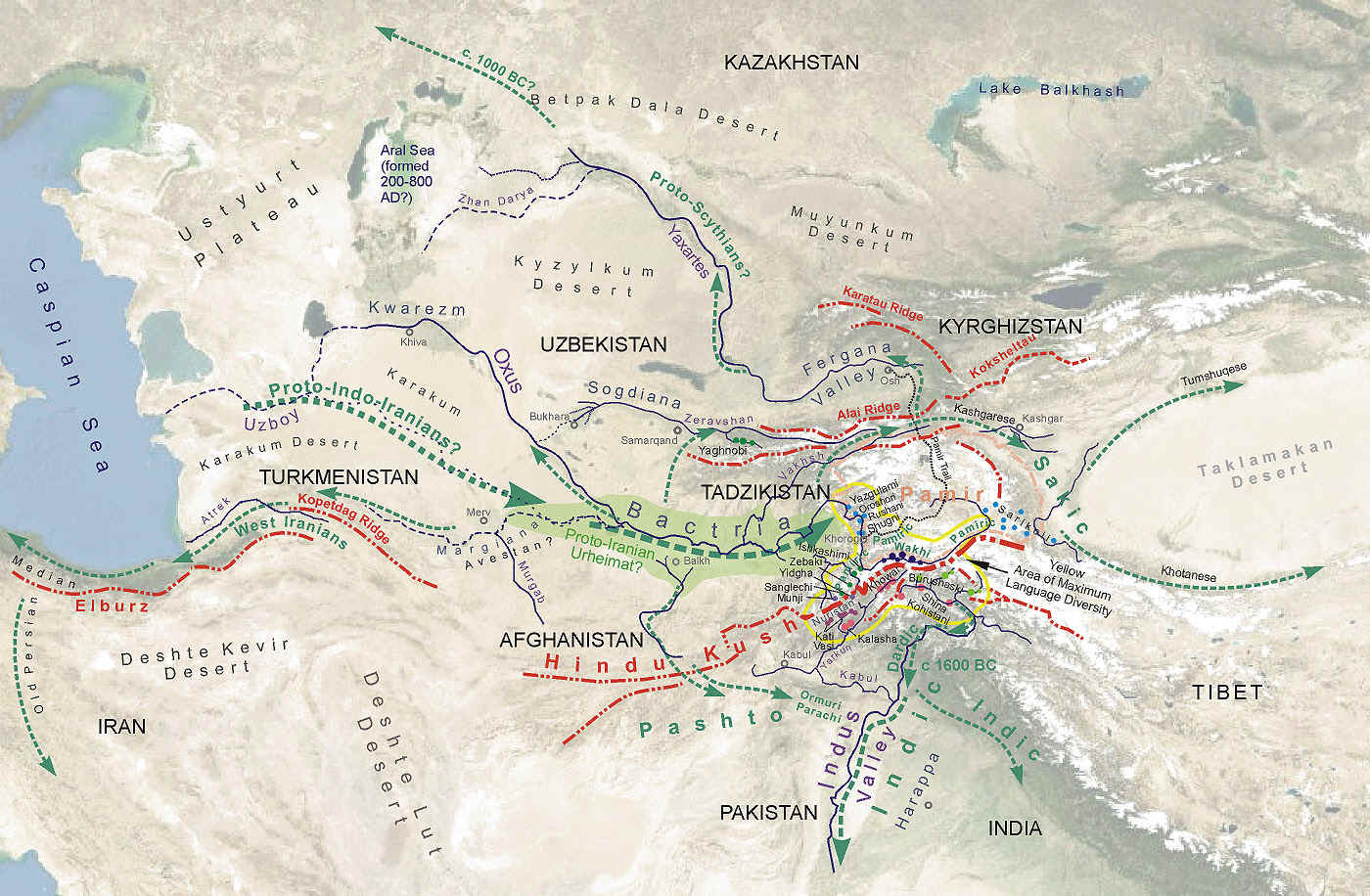
Indo-Iranian Migrations, http://indo-european-migrations.scienceontheweb.net/Indo_Iranian_migrations.html
Indo-Aryan religion. Most
of what we know about these early Indo-Aryans comes through their
religious texts, the Vedas. The Vedas were hymns to the gods in which
the people expressed their ideal conceptions of religion and society.
The Vedas were originally an oral tradition. The oldest, the Rig-Veda,
or "Verses of Knowledge," is a collection of
more than 1,000 ancient hymns used in rituals and sacrifices. Although
it had probably been compiled by 1000 B.C., the Rig-Veda was not
written down until about A.D. 1300.
The Indo-Aryans worshipped many gods, whom they associated with the forces of nature. Two of the most important were Indra, god of storm and war, and Varuna, who was associated with the sky. The Indo-Aryans worshipped the gods in a complex ritual based on the sacrifice of food items and animals. As they intermingled with the earlier Indian peoples, the Indo-Aryans also began to blend older Indian gods and traditions with their own.
Indo-Aryan society. As the
Indo-Aryans established their rule over the earlier inhabitants of
India, their language, an early form of Sanskrit, soon spread over
much of India. Preserved as a sacred language, Sanskrit is the oldest
version of an Indo-European language remaining today. Indo-Aryan
social structure also spread. According to the Vedas, the Indo-Aryans
at first recognized three great classes, or varnas. Probably,
reflecting their importance in the survival of the Indo-Aryans during
the early years of migration and conquest, the Kshatriya, or warrior
nobles, were initially viewed as the highest class. As the migrations
ended and kingdoms were established in northern India, however, the
migrants settled down and adapted themselves to an essentially
sedentary, agricultural existence. As the cycles of the growing
seasons replaced warfare as the central feature of life, the warriors
were displaced in the social hierarchy by the Brahmins, the priests
who performed the sacred rituals that people believed were essential
to preserve the natural order. Instead of warfare, these rituals
became the center of people's sense of security - and thus the
Brahmins became the leaders of Indian society. Below the priests and
warrior nobles, the third and largest varna was the Vaisya - comprised
of merchants, traders, and farmers. A fourth varna, the Sudra,
made up of artisans and servants, was apparently added later to
incorporate non-Aryan Indians into the Indo-Aryan scheme of society
and religion. The first three classes considered the Sudras unclean,
and forbade them to study or hear the sacred hymns of the Vedas.
According to the Rig-Veda, the varnas had been created along with all
other forms of life when Purusha, the universal spirit, was sacrificed
to himself:
The
Brahmin
was his mouth, of both his arms was the [Kshatriya] made. His thighs
became the Vaisya, from his feet the Sudra was produced. . . . Indra
[the chief god] and Agni [god of fire] from his mouth were born, and
Vayu [the wind] from his breath.
Political
structure of northern India.
By the 600s B.C. the Ganges Valley had become the center of Indian
civilization. The Indo-Aryans had learned to cultivate rice, allowing
increased food production and thus a rapidly expanding population.
With growing numbers to support larger armies, many kingdoms gradually
developed on the flat plains. At the head of each state was a raja,
or king, usually a member of the Kshatriya. According to the Rig-Veda,
"the king abides prosperous in his own abode. The earth bears
fruit for him at all seasons. His subjects willingly pay homage to
him." The kings lived in palaces and wore brilliant clothes that
set them apart from others. In addition, the Rig-Veda also indicates
that the kings had councils composed of noblemen, who were also
Kshatriyas.
Southern
India. Far less is known about developments in southern India. Archaeological
evidence suggests that development in the southern regions was much
slower than in the Indus and Ganges Valleys. People in the south
learned metalworking later, and while the north united into large
kingdoms, the south remained fragmented. Nevertheless, the south was
also affected by the spread of Sanskrit and Indo-European ideas. Thus,
the peoples of the south also eventually identified themselves as
Brahmins, Kshatriyas, Vaisyas, and Sudras.
One reason that the south developed
later was its difficult geography. The jungle-clad Vindhya Mountains
cut off the southern part of the Indian peninsula, called the Deccan, from the
technological advances of the north. In addition, much of the terrain
in the Deccan is hilly, which made consolidating territory more
difficult than in the flat plains of the north. A major consequence of
this comparative isolation by land, however, was that many peoples of
the south turned to the sea. Through coastal ports, they eventually
established important trade contacts with other regions around the
Indian Ocean and in Southeast Asia.
Shang China
INTERNET RESOURCE: Shang China
Like the rest of
Eurasia, people in China too felt the impact of the new war
technologies developed first by the Indo-Europeans further west. From
about 4000 B.C., people
in China had practiced agriculture in the valley of the Huang He.
Farmers used stone tools and lived in small villages in isolated
clearings along the river valley. In the second millennium, however,
chariot-driving invaders dominated the farming populations of the
Huang He valley. These invaders were a tribe called the Shang.
Although it is unlikely that Indo-European groups themselves actually
migrated so far east, the technology of their war chariots probably
passed from one group of people to another across the Eurasian
steppes. Probably in western China, the Shang became the latest to
adopt the new warfare techniques and use it to take control of a river
valley population.
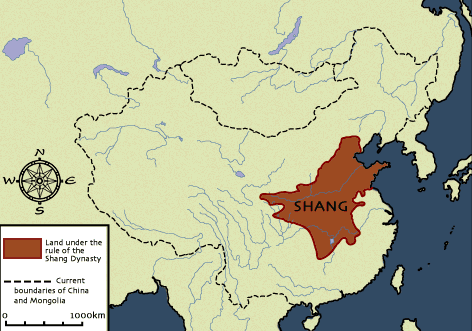
http://www.history-of-china.com/img/shang-dynasty-map-b.gif
Shang government. Sometime between 1750 and 1500 B.C.,
the Shang established their rule over the Huang He region. They
established the first historically verifiable dynasty in China. Under
the Shang, China developed a complex bureaucracy to rule its expanding
empire. At the center of this bureaucracy was the king,
a member of the Tzu clan.
The king, who was believed to be a descendant of the gods, was the
supreme military leader, commanding
the armies against neighboring peoples. At its height,
the Shang Empire stretched over 40,000 square miles,
about the size of Kentucky.
The Chinese believed that kings should rule fairly, especially
to curry the favor of the gods for his people. King Tsu Chia was
praised for his justness:
Tsu
Chia...refused to
be king unrighteously, and was at first one of the lower people. When
he came to the throne, he ... was able to exercise a protecting
kindness toward their masses. He did not dare to treat with contempt
wifeless men and widows. Thus it was that he enjoyed the throne thirty
and three years.
However, the ruler had
to produce results, and rebellions broke out when he failed. Poor
crops or defeat in battle meant the ruler no longer had the support of
the gods and had lost his right to rule.
Shang economy and handicrafts. Like earlier civilizations, the Shang
economy was built on agriculture. Farmers grew millet, wheat,
vegetables, and fruits, and they raised cattle, chickens and pigs for
meat.
However, farmers did not own their land. The king owned all territory
within the Shang Empire
To give continuance to foremothers and forefathers
We build a house, many
hundred cubits of wall;
Here we shall live,
here rest,
Here laugh, here talk.
In these towns lived
specialized workers, such as wood carvers, leatherworkers, and
stonecutters.
Sometime during the Shang dynasty, artisans learned to raise
silkworms, to spin thread from their cocoons, and to weave silk cloth
from the thread.
The bronze castings of Shang artisans are widely regarded as
outstanding works of art. The technique of casting may have spread to
China from the Middle East, possibly Sumer, though some scholars argue
that it developed independently in China itself. Clearly, however, the
forms of the Shang vessels and the designs of the decorations were
uniquely Chinese. Chinese artisans cast small figures as well as large
ceremonial vessels whose surfaces featured delicate embellishments.
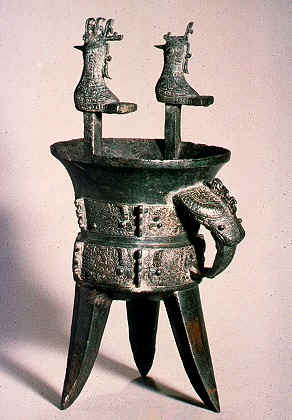
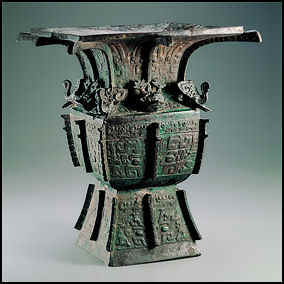
Examples of Shang bronze ritual vessels, (above left) http://acc6.its.brooklyn.cuny.edu/~phalsall/images/shngbrn1.jpg, (above right) http://factsanddetails.com/media/2/20080302-Bronze%20vessel%20Late%20shang%20tapei.jpg
Shang religion. The religion that developed during the Shang dynasty
combined ancestor worship and animism,
or the belief that all things in nature had a spirit. The Chinese
worshipped the gods of the wind, earth, sun, moon, and clouds.
However, the most important god was Ti, who had the power to provide
abundant harvests or victories in battle.
The Chinese also believed that the way to influence Ti was
through the king’s ancestors. The king communicated with his
ancestors through diviners, or priests. The diviners made incisions on
tortoise shells or cattle bones, called oracle
bones, which they heated over a fire. They used the pattern of
cracks that appeared to interpret the answers. Diviners consulted the
oracle bones during ritual sacrifices, requests for good weather, or
for interpretation of events such as dreams, illness, or death.
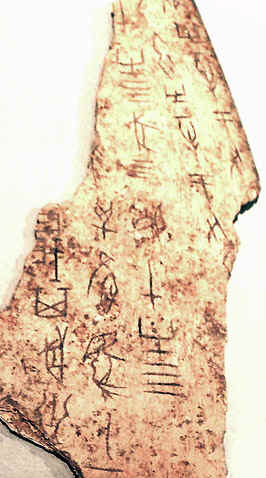
Example of a Shang oracle bone, http://upload.wikimedia.org/wikipedia/commons/b/be/Shang-Orakelknochen_excerpt_adjusted_for_contrast.jpg
Development of writing. The style of writing that developed during
the Shang period is remarkably similar to Chinese writing today.
Instead of using a phonetic system of writing, the Chinese assigned a
special symbol, or character, to every word in their language. At
first these characters were pictograms,
or drawings of objects. As the language became more complex, the
Chinese developed ideographs, which conveyed ideas rather than
pictures. As the language developed, these characters modified
somewhat, but they are still similar enough that an untrained reader
can understand many ancient Chinese symbols.
Unlike the Indo-Aryans, the early Chinese used writing to
compose and preserve literary works. Writing itself became an art,
called calligraphy. Characters were written with a brush in lines that
ran from the top to the bottom of a page, beginning on the right side.
Because the art of calligraphy was so difficult to learn, great
calligraphic skills were considered to be evidence of a good
education.
Fall of the Shang dynasty. The Shang kingdom collapsed in the early 1100s B.C., apparently because the last Shang king, Ti Hsin, exhausted his kingdom’s strength in wars against nomads to the north and east. He failed to guard the frontier where the Zhou (joh) were rebelling. Led by Wu Wang, the Zhou formed an alliance with several nearby tribes and invaded the Shang kingdom. King Ti Hsin killed himself, and Wu Wang seized control of the Shang capital.
The Western Zhou Dynasty
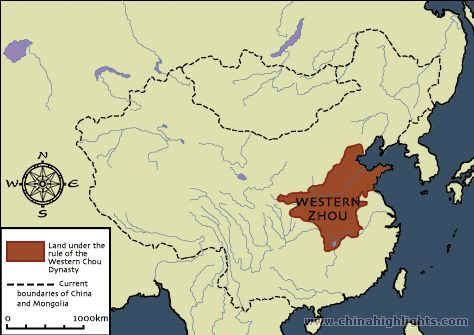
Area controlled by the Western Zhou Dynasty, from about 1122-771 B.C. http://www.chinahighlights.com/map/ancient-china-map/western-zhou-dynasty-map.htm
The Zhou believed that
the gods determined who should rule China, a right known as the Mandate of Heaven. When the Zhou conquered the Shang, they called
themselves the Sons of Heaven, because the Mandate of Heaven had
passed from the Shang to the Zhou.
The Zhou political order. After the last Shang king was overthrown,
the Zhou campaigned for years to consolidate power. Rebellions by the
remaining Shang and their allies drove the Zhou to create a new system
for preserving order.
Many scholars refer to this system as a kind of
feudalism, by which they
generally mean a decentralized power structure characterized by bonds
of individual loyalty between rulers and their nobles, and the nobles
and their warriors.
In Zhou China as in Shang China, the king owned all of the land
in China. In the Zhou feudal order, however, the king gave the right
to control land in strategic locations to his kinsmen, who
became lords. They built fortified cities to use as bases from which
to conquer the outlying lands in the name of the king. Because the
king and his lords were related, the bonds between them were stronger
than if their relationship had been solely based on duty and
obligation. Over time, however, these lords became quite powerful, as
local people looked to them as their protectors. As the lords grew
stronger, the power of the king diminished.
Zhou society was divided into classes. At the top was the
king and the royal family, which included most of the hereditary
feudal lords. Aristocratic warriors supported the lords, and together
they ruled over the masses of peasants and slaves that made up the
majority of the Chinese population.
Decline of the Zhou dynasty. However, by the 800s B.C.,
Zhou power began to disintegrate. The feudal lords grew less loyal to
the king, and invading nomads chipped away at Zhou strongholds. A
popular uprising drove out the tenth Zhou king in 841 B.C.,
and a period of disruption began.
The greatest threat to the Zhou kingdom came in 771 B.C.
According to tradition, King Yu had a new consort named Pao-Ssu that
he wanted to please. To make her laugh, he raised an alarm by lighting
signal fires and sounding a big drum. When the feudal lords hurried to
defend the king, they found no enemy, merely Pao-Ssu and King Yu
laughing. Later, when barbarians really did attack the royal capital,
King Yu again raised the alarm - but the feudal lords did not respond.
King Yu was killed, Pao-Ssu was captured, and the Zhou dynasty in the
west came to an end.
King Yu’s son fled eastward to establish what became known as the Eastern Zhou dynasty. The period before 771 B.C. became known as the Western Zhou dynasty. The kings of the Eastern Zhou, however, were never able to attain any real political or military power. Instead, local nobles became the real powers in China, ruling their own territories virtually as independent, and increasingly rival, states. As China descended into greater and greater disunity, later Chinese historians looking back came to divide the history of the Eastern Zhou dynasty into two periods, the Spring and Autumn Period, which lasted until about 475 B.C., followed by the Era of Warring States.
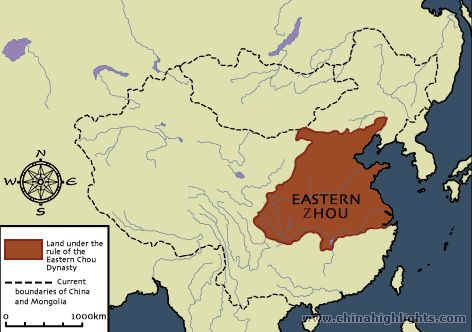
Territory
of the Eastern Zhou Dynasty, 770-256 B.C. http://www.chinahighlights.com/map/ancient-china-map/eastern-zhou-dynasty-map.htm